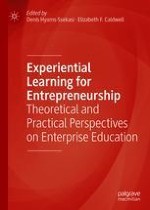2018 | OriginalPaper | Chapter
7. A Holistic Approach to the Delivery of Effective Enterprise Education
Authors : Veronica Scuotto, Alan Murray
Published in: Experiential Learning for Entrepreneurship
Publisher: Springer International Publishing
Activate our intelligent search to find suitable subject content or patents.
Select sections of text to find matching patents with Artificial Intelligence. powered by
Select sections of text to find additional relevant content using AI-assisted search. powered by
